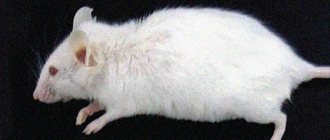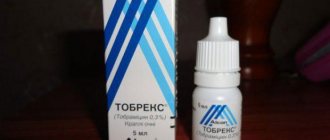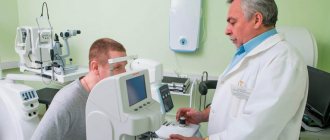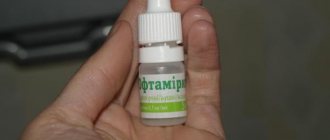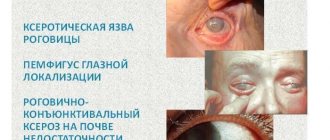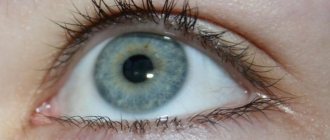Review of effective drugs for adults
To choose effective and safe antibacterial eye drops, you should consult an ophthalmologist. To combat bacterial infections, the doctor will select an effective medicine.
Tsiprolet
This product contains ciprofloxacin. It is used not only for the development of various pathologies. The drug is actively used for disinfection and prevention of secondary infection after operations and traumatic injuries to the organ of vision.
The medication may cause temporary reactions. They manifest themselves in the form of itching and burning sensations. The person's vision may become blurred. This is a variant of the norm. In such a situation, therapy should not be discontinued. The exception is situations where such effects are present for more than a few minutes and are accompanied by severe pain.
https://youtube.com/watch?v=TeJW6cTSvF4
The medicine is administered into the eyes 2-3 times a day. The doctor may also recommend other options for using the substance.
Tobropt
The drug is an analogue of Tobrex. It has bactericidal and bacteriostatic characteristics. With the help of the medicine it is possible to influence not only bacterial microorganisms, but also certain categories of fungi.
The substance can be instilled up to 5 times a day. The course of therapy is selected depending on the characteristics of the pathology.
Sofradex
This is a fairly powerful drug that includes several antibacterial components - framicidin and gramicidin. It also contains a hormonal component - dexamethasone.
The medicine should not be combined with the use of other antibacterial drops, as there is a risk of serious adverse reactions.
The product must be injected into the eyes 2 times a day. The course of treatment does not exceed 1 week. Longer therapy leads to superinfection.
Albucid
This antibiotic is very popular. It is actively used to combat bacterial conjunctivitis, blepharitis and other infections. For adult patients, the medicine is administered up to 6 times a day. As the severity of the symptoms of the disease decreases, the number of instillations is reduced.
The drug is often prescribed to children. However, it is worth considering that it causes a pronounced burning sensation in children. Therefore, it is worth using the product for children under 5 years of age only taking into account the child’s reaction.
Review of hormonal drugs
Based on dexamethasone
Maxidex - eye drops containing dexamethasone 0.1%. The drug is prescribed for allergic reactions of the conjunctiva and inflammation of a non-bacterial nature. Like all corticosteroids, it cannot be used against the background of smallpox, herpes, or actinomycosis.
Side effects are typical for this group of drugs and require careful monitoring of IOP. Dexamethasone increases intraocular pressure the most among the group of ophthalmic corticosteroids.
Also, ophthalmic corticosteroids should not be used simultaneously with non-steroidal anti-inflammatory drugs, since this combination delays the healing of wounds on the cornea and leads to its thinning and the formation of ulcers.
GCS drugs are prescribed to pregnant women only for essential indications. Although there is no data on the penetration of the drug into breast milk, you should refrain from feeding the baby during treatment. There is no evidence of significant effects in children.
Treatment begins with 1-2 drops every hour, then the dosage is gradually reduced by reducing the frequency of administration - every 4 hours, and then to once a day.
Based on fluorometholone
Flarex is an eye drop that has pronounced anti-inflammatory, anti-edematous and anti-allergic activity. They are used to prevent collagen deposition and scar formation, as well as for persistent non-purulent and allergic conjunctivitis, keratoconjunctivitis, blepharitis, scleritis, optic neuritis, inflammation after eye trauma and surgical interventions. Drops based on fluorometholone contribute least to increasing IOP.
You need to instill the drug 1-2 drops two to four times a day. Use in conditions where the integrity of the cornea is compromised is fraught with the development of a fungal or bacterial infection.
The drug can be prescribed to pregnant women and children only if the expected positive effect prevails over possible adverse reactions - an increase in IOP, the development of cataracts.
The drops are produced in the form of a suspension, so before use the bottle must be shaken several times to form a homogeneous solution.
Based on prednisolone
Prednisolone ophthalmic suspension 0.5% – steroid ophthalmic drops. Used only topically to relieve symptoms of inflammation caused by allergies, injury or surgery.
Drops should not be used if you are allergic to prednisolone or other steroids, or if you are allergic to certain types of ophthalmic infections (viral, fungal or bacterial).
These drops should not be used on contact lenses because this medication contains a preservative that can be absorbed by soft contact lenses and cause discoloration. Wait at least 15 minutes after using prednisolone before inserting contact lenses.
If after two days of using Prednisolone the swelling of the eyes does not decrease, you should immediately consult a doctor.
Use this medicine only according to the schedule and in the amounts that your doctor determines for you, since the withdrawal of the drops should occur very smoothly.
This drug is found on the domestic market under the name Prednisolone suspension, but there are also its imported analogues: Inflamase Forte, Omnipred, Prednisol.
Based on budesonide
Prenacid is an ophthalmic drop with a local hormonal component. They have proven themselves in the treatment of inflammatory diseases such as allergic reactions, scaly blepharitis, thermal or chemical damage to the cornea.
Side effects are typical for all GCS; intraocular pressure may increase after two weeks of systematic use. Drops should not be used for tuberculosis, viral or fungal diseases of the cornea, as well as for its abrasions and possible thinning.
Based on lotoprednol
Alrex or Lotemaks eye drops contain topical corticosteroids and are intended to eliminate the symptoms of allergic spring conjunctivitis.
Combinations
Mono preparations of glucocorticosteroids are used mainly to suppress immunological inflammation, relieve itching, swelling, and redness. But often after surgical procedures, prevention of bacterial infection of the eyes is also required. Therefore, there is a large group of drugs that are stable combinations of GCS with antimicrobial drugs. Such ophthalmic agents are also used to treat staphylococcal blepharoconjunctivitis, microbial allergic keratitis, episcleritis, dacryocystitis, and eye injuries.
Advantages of combination drugs:
- there is no need to wait a pause between applying several types of drops to the eye;
- you can be sure that there will be no unexpected chemical or therapeutic interactions between drugs;
- Also, in one drug you can get well-selected and proven doses of several drugs.
Combinations with betamethasone: drops that can be instilled into the eyes and ears - Garazon. They contain the antibiotic gentamicin. The frequency of administration is 1–2 potassium up to four times a day.
Combination with dexamethasone: Sofradex drops, which exhibit their antibacterial activity thanks to the antibiotics neomycin and gramicidin. To maintain an overwhelming concentration of antibacterial components, drops should be instilled frequently - up to six times a day.
Dexamethasone and neomycin are also successfully combined with another antibiotic, polymyxin B, which is active against most pathogens of ophthalmic infections. This composition is contained in the drug Maxitrol, Neladex. In the acute period of the disease, they can be used every hour, gradually reducing the frequency of administration to four times a day.
One of the most effective and safe antibiotics of the aminoglycoside group, Tobramycin, in combination with dexamethasone, is included in the eye drops Medetrom, Dexatobrom, Tobradex. They can be used even in children older than 12 months.
There is also the option of combining dexamethasone with neomycin in Dexon drops. Due to their activity, drops can be used both in ophthalmology and for the treatment of diseases of the external ear.
Combinations with hydrocortisone – Gikomycin-Teva. These drops contain dexamethasone and neomycin. Start taking 2 drops into the affected eye every 2 hours, and then switch to four instillations during the day.
Combinations with prednisolone - Loxtra drops. They contain the fluoroquinolone antibiotic ofloxacin and the vasoconstrictor component – tetrahydrozoline hydrochloride. This composition allows you to cope well with swelling and inflammation that arise against the background of a bacterial infection.
Since hormonal eye drops have serious side effects, they should only be prescribed by a doctor, taking into account existing pathologies and concomitant conditions.
Source of the article: https://gsproekt.ru/lechenie/gormonalnye-kapli-glaz
Recommendations for use
Eye drops are a simple but responsible procedure, and it must be carried out competently. Careless instillation can damage the eye and cause infection. To prevent this from happening, certain rules must be followed:
- Wash your hands before instillation;
- Do not touch the tip of the bottle with your finger;
- If it is a pipette, then it must be boiled before the procedure;
- The drops should be kept in the refrigerator, and an hour before instillation, take them out and keep them at room temperature (or warm the bottle in warm water) so as not to cause cooling of the eye and increased inflammation;
- The number of drops should not be more than two, otherwise they will either simply flow out of the eye, or enter the nasolacrimal canal, into the paranasal sinuses (which is even worse);
- The position when instilling should be horizontal - tilted back;
- You only need to drip into the lower conjunctival sac at the inner corner of the eye, slightly pulling the eyelid down and without touching the eye with the pipette;
- If several types of drops are prescribed, they cannot be used simultaneously. You need to wait half an hour after the first drops, and then use others.
Types of antibiotics for the eyes
In pharmacies, eye drops with antibacterial ingredients are available in a wide range. Among them there are many single-component products. The composition of the drugs includes a certain antibiotic and auxiliary substances. They often become the first choice in the treatment of children and debilitated patients. Such ophthalmic solutions do not burden the body pharmacologically and are well tolerated. But they also have a significant drawback - in some cases, they require the use of drugs to eliminate pain.
Recently, various multi-component products have been most in demand. They contain not only one or two antimicrobial components, but also other active ingredients. Most often these are synthetic analogues of hormones produced by the adrenal glands (glucocorticosteroids):
- dexamethasone;
- prednisolone;
- betamethasone;
- hydrocortisone.
Antiseptic agents are included in a separate group. They do not contain antibiotics, but they have pronounced antimicrobial activity. These drugs include Okomistin with the main substance miramistin.
Eye drops with an antiseptic effect, for example, the well-known Albucid, are considered universal. They suppress not only the growth of pathogenic bacteria, but also inhibit the proliferation of viruses and yeast-like fungi.
Fluoroquinolones
This is the name given to chemical compounds from the group of antibiotics, which are characterized by pronounced antimicrobial activity. Most pathogenic microorganisms, with the exception of anaerobes, are sensitive to their action. Fluoroquinolones inhibit microbial cell enzymes, disrupting DNA synthesis, which leads to the death of bacteria. They also influence RNA, and also increase cell permeability to fluid and macroelements. In ophthalmic practice, eye drops with the following antibiotics from the fluoroquinolone group are used:
- ciprofloxacin;
- norfloxacin;
- ofloxacin;
- levofloxacin.
The high bactericidal activity of fluoroquinolones allows them to be used in the treatment of almost all infectious eye pathologies. They are relatively safe, and their use rarely causes local or systemic adverse reactions.
Aminoglycosides
Aminoglycosides are organic substances characterized by the presence of an amino sugar in the molecule. The main clinical significance of aminoglycosides is their activity against aerobic gram-negative bacteria. Eye drops with these antibiotics are most in demand in the treatment of bacterial conjunctivitis, keratitis, and ulcerative lesions of the cornea. Patients are prescribed medications with the following active ingredients:
- tobramycin;
- neomycin;
- gentamicin;
- amikacin.
Aminoglycosides are bactericidal antibiotics that directly destroy microorganisms that are sensitive to them. Therefore, these drugs are prescribed to patients when severe infectious diseases are detected.
Macrolides
Macrolides are a group of drugs whose chemical structure is based on a macrocyclic ring. For the treatment of eye pathologies, products containing erythromycin, clarithromycin, midecamycin, josamycin, and azithromycin are often used.
Levomycetin
Eye drops with the antibiotic chloramphenicol have a wide spectrum of action. They destroy gram-positive and gram-negative bacteria, including E. coli. Levomycetin does not show activity against mycobacteria, Pseudomonas aeruginosa, Proteus, and almost all protozoa.
The main medicinal properties of hormonal drops
Hormonal eye drops have a number of important properties that make them indispensable in the treatment of complex eye pathologies.
So, among these will be:
- strong anti-inflammatory effect;
- relief of allergic reactions.
Hormonal drops for eye inflammation
In the treatment of inflammatory processes, steroids are often used in combination with antibiotics.
In their pure form, the use of hormones is prescribed for a short period of time. They are not intended for children, pregnant or lactating women. The instructions for use advise, when instilling the medicine, to measure intraocular pressure and monitor the condition of the eye structures. Steroids are used for the following pathologies of the ocular structures: non-infectious inflammatory processes in the anterior part: iritis, iridocyclitis, uveitis, scleritis, keratitis without damage to the corneal epithelium, and allergic conjunctivitis, blepharitis, after injuries and surgical interventions (only 3-5 days after surgery) .
Among the drugs containing only corticosteroids will be the following.
- Prednisolone. This is a dehydrogenated analogue of hydrocortisone. It relieves well non-infectious inflammation of the structures of the anterior part of the eye, in case of injuries and burns, after complex operations, but requires control of intraocular pressure.
- Dexamethasone. It often provokes a burning sensation immediately after use, and side effects include steroid cataracts. Enhances the effect of barbiturates, warfarin, but reduces erythromycin, cinnarizine, amlodipine, verapamil and other calcium channel blockers. Dexamethasone is used in the treatment of inflamed processes in the structures of the anterior segment of the eye, after operations. The drug is not prescribed for viral infections caused by herpes. It cannot be instilled onto contact lenses; they can only be put on 30 minutes after the procedure.
- Betamethasone. Betamethasone valerate and betamethasone propiate are used for ointments and creams, and betamethasone disodium phosphate is used in drops and solutions for IV and subconjunctival injections. It is prescribed for viral conjunctivitis caused by the herpes virus, non-infectious diseases of the anterior segment of the eye, after operations. The drug can, in addition to other side effects characteristic of steroids, provoke thinning of the sclera.
- Prenatsid. Active ingredient: desonide. It reduces the permeability of blood vessels in the eyeball and helps stabilize lysosomes. The drug, in addition to the treatment of non-infectious inflammation of the anterior segments, is also indicated in the treatment of inflammation of the posterior segment of the eye: choroiditis, chorioretinitis, optic neuritis.
Hormonal drops for allergies
Hormonal eye drops for allergies are used for no longer than 6-7 days. They relieve swelling and itching, eliminate inflammation. Drugs from this group block the allergen (H1-histamine receptor blocker) and also promote the production of antigens.
The use of steroids for allergies is a last resort. They are prescribed in cases where all other methods have been tried and they have not helped.
Among the popular and effective eye drops are the following.
- Levacabastin perfectly relieves redness of the eyelids and conjunctiva, itching, and lacrimation. Levacabastin is indicated for allergic conjunctivitis. When instilled in recommended doses, it does not lead to side effects. It is used for the eyes, and also for allergic rhinitis as nasal drops.
- Loteprednol Drops is a corticosteroid for all types of allergies: seasonal, drug-related, after surgery, it perfectly relieves swelling, itching, pain. Do not use for bacterial and fungal infections.
How to put eye drops against viral conjunctivitis
Eye drops for viral conjunctivitis contain components that suppress the reproduction of the virus (interferon alpha 2) or stimulate the production of the body's own interferon. They can have a regenerating, calming effect on the conjunctiva.
Eye drops for viral conjunctivitis should be prescribed by a doctor. It is he who determines the form of the disease and chooses therapy, taking into account the causative agent of the disease. For adenoviral conjunctivitis, one drop is prescribed, and for enteroviral conjunctivitis, another.
There are antiviral drugs for adult patients that significantly speed up the healing process.
Oftalmoferon
The drug contains human interferon, which suppresses the virus. Another active component of the drug, diphenhydramine, relieves itching, which often accompanies the disease.
The doctor will prescribe the regimen for use. Usually this is 6 times a day in the first days, then 3 times a day. The duration of treatment is 5–7 days, during which a noticeable improvement should occur. The medicine is well tolerated without causing side effects.
Cost: 300–350 rubles.
Florenal
Very good drops for viral conjunctivitis. The medication has a pronounced antiviral effect, suppressing the reproduction of the virus in the tissues of the eye. Available in the form of ointment and eye films. Proven effectiveness against herpes viruses.
The active ingredient can cause side effects that are expressed in discomfort after instillation: the eyes burn a little, and mild itching may occur. They are usually short-lived and do not require discontinuation of the drug.
Aktipol
Contains para-aminobenzoic acid – an interferon inducer. The active substance stimulates the production of its own interferon in tissues, enhancing the body’s fight against the virus that attacks it. In addition to fighting the virus, Aktipol relieves swelling of the eyelids. It has an antioxidant effect, activates cell renewal, promotes the regeneration of damaged mucosa and regulates the water-salt balance of eye tissue.
Cost: 300–360 rubles.
Instillation of moisturizing solutions is also often prescribed, since viral conjunctivitis is usually accompanied by dry vision.
Types of antiallergic eye drops
Vasoconstrictor drops
These drops cause a constriction of the blood vessels in the mucous membrane of the eye and reduce such manifestations of an allergic reaction as swelling of the conjunctiva and, due to spasm of the conjunctival vessels. Drops for an allergic process are used for a short time: more than two or three days. With their long-term use, a “withdrawal effect” may develop - all allergy symptoms suddenly return again. This group of medications includes the following eye drops: “Octilia”, “Vizin”, “Okumetil”.
Antihistamine eye drops
To treat allergic manifestations of the eye, antihistamine eye drops should be used as the first remedy. They prevent the accumulation of the main immediate mediator of allergic reactions, histamine. With the help of these drops, such manifestations of an allergic reaction as swelling are reduced. Antihistamine eye drops that should be used for emergency treatment of allergies include Spersallerg, Lecrolin, Allergodil, Opatanol.
Anti-inflammatory eye drops used for allergies
To relieve the manifestations of acute allergic reactions, eye drops are prescribed that contain anti-inflammatory active ingredients. Such drugs are divided into two groups: nonsteroidal anti-inflammatory drugs (NSAIDs) and corticosteroids.
Non-steroidal anti-inflammatory drops
In order to reduce inflammation, swelling and other manifestations of an allergic reaction of the eye, non-steroidal anti-inflammatory drugs such as "", "Naklof", "Diklo F", "" can be used in the form of eye drops.
Corticosteroids
To relieve an acute allergic reaction, eye drops containing corticosteroids are often prescribed. With prolonged use, side effects of these drugs may occur, so they are prescribed only for a short term. Corticosteroid drops include Prenacid, Dexamethasone, and Maxidex.
Mast cell stabilizers
Drugs in this group cause specific changes in the main (mast) cells involved in the allergic process, from which histamine is released. They are not a means of emergency treatment, since their effect appears only after accumulation. Mast cell stabilizers should be used to prevent allergic reactions in the lead-up to seasonal allergies. For this purpose, eye drops such as Cromohexal, Lecrolin, Alomide are prescribed.
Tear substitutes
An allergic reaction causes irritation of the eyes, which become red and dry. This increases itching, swelling, and discomfort in the organ of vision. To moisturize the conjunctiva of the eyes, you should also use substitutes that have no side effects or contraindications and can be instilled into the anterior area as often as needed. They must be stored in the refrigerator, as cool liquid has a more soothing effect. Tear substitutes such as “Artificial tear”, “Natural tear”, “Systane”, “Vidisic” are absolutely safe.
Features of the drugs
All types of eye drops have a number of common properties. An important feature of such agents is the ability to quickly penetrate through the conjunctiva, the outer shell of the eye, into the deeper parts of the eyeball.
Each drug has its own characteristics: it contains its own active substance, is used for a specific purpose and is included in one or another group of eye drops.
- Antibacterial eye drops are used to fight various types of infections. This is the largest pharmacological group, which, in turn, is divided into several subgroups. There are antibacterial, antiviral and antifungal eye drops, and by the nature of the active substance - antibiotics, chemotherapeutic drugs and antiseptics.
- Anti-inflammatory eye drops are intended to treat inflammatory lesions. the organ of vision and its appendages of a non-infectious nature. This group, in turn, is divided into steroidal anti-inflammatory drops (hormonal anti-inflammatory drops) and non-steroidal anti-inflammatory drops. Both of them can consist of several components that expand their spectrum of action. (For example, Thiotriazoline eye drops).
Average price: 100 rubles.
- Drops for eye pressure are divided into 2 large groups: medications that improve the outflow of intraocular fluid, and medications that reduce its production. For example, Azarga eye drops and its analogues will be effective.
- Antiallergic eye drops are intended for the treatment and prevention of allergic reactions. The principle of action of these drugs is to suppress the initiation of the inflammatory reaction at the cellular level or to block histamine receptors.
- Local vasoconstrictor drugs relieve symptoms of allergic inflammation, such as swelling and hyperemia, and significantly reduce pain.
- Eye drops used for cataracts slow down their development.
- Moisturizing eye drops, or “Artificial tears,” are intended to prevent dry eye syndrome.
- Diagnostic eye drops are used during surgical procedures.
Delfanto® capsules – prevention of ophthalmic pathologies
It is no secret that one of the frequently diagnosed pathological conditions is dry eye syndrome. The lack of adequate and timely therapy for this diagnosis leads to the development of chronic inflammation of the eye tissues, keratitis, and corneal ulceration. To avoid this, you need to carry out timely prevention. The innovative product Delfanto® will help solve this issue.
The active ingredient of the capsules is a standardized MaquiBright® extract, which is produced in Germany. It contains about 35% of the most important antioxidants for the eyes, which is an absolute record for such products. They have a number of positive properties:
- eliminate the effects of oxidative stress;
- restore lacrimal gland cells and their functions;
- normalize the production of tear fluid.
1-2 capsules a day are enough to protect your eyes from dryness and fatigue. Delfanto® can be used even by those patients who prefer to use contact lenses for vision correction.
Composition of antibacterial and anti-inflammatory drops
The composition of these topical products varies significantly depending on the formulation. They can be single-component or contain several ingredients at once, and of different clinical and pharmacological groups. What active ingredients are often included in ophthalmic preparations:
- antibiotics - macrolides, cephalosporins, fluoroquinolones, semisynthetic penicillins;
- antimycotics to eliminate an attached fungal infection;
- glucocorticosteroids are synthetic analogues of hormones produced by the adrenal glands.
The composition of antibacterial and anti-inflammatory drops is designed in such a way that during their treatment, almost all signs of infectious eye pathology weaken and then completely disappear. Therefore, doctors often prefer to prescribe combination drugs with different pharmacological properties to patients.
The most famous hormonal drops and their characteristics
Currently, a significant number of types of hormonal eye drops are known. The most popular and effective of them include Sofradex, Tobradex, Maxitrol, Dexamethasone, as well as some others.
The combination medicine Sofradex contains both hormonal and antibiotic substances, thanks to which the use of these drops guarantees an excellent antibacterial and anti-inflammatory effect. In addition to the main active ingredient framycetin, the drops also contain a number of other components: dexamethasone, gremacitin, distilled water, phenylethyl and methylated alcohol, sodium citrate, lithium chloride, polysorbate 80 and citric acid. This drug is prescribed for diseases such as allergic conjunctivitis, keratoconjunctivitis, scleritis, blepharitis, iradocyclitis and some others. The maximum course of treatment with this drug is one week.
Maxitrol drops contain dexamethasone, as well as the antibiotics polymyxin B and neomycin.
This drug is used to treat conjunctivitis, keratitis, blepharitis, keratoconjunctivitis, iridocyclitis and some other infectious diseases.
Tobradex is a drug based on dexamethasone and tobramycin, which are the main active ingredients. The additional components present here are sodium sulfate, distilled water, benzalkonium chloride, hydrochloric acid, disodium edetate and other substances.
Dexamethasone drops, in addition to the main active ingredients (dexamethosan and sodium phosphate), contain distilled water for injection, benzalkonium chloride, disodium edetate, boric acid and borax. This drug is indicated for use in the case of eye diseases such as keratitis, various types of conjunctivitis, blepharitis and some others. Immediately after contact with the mucous membranes of the eye, Dexamethasone drops begin to quickly enter the epithelium, as a result of which the entire inflammatory process is completely eliminated. This effect occurs approximately eight hours after using the drops.
Indications
When prescribed correctly, steroid treatment is invaluable in ophthalmology, especially in the postoperative period, since largely thanks to hormonal drops it is possible to preserve implanted lenses and prevent excess formation of connective tissue and scarring during postoperative ocular inflammation or vitrectomy.
Hormonal drops are prescribed to eliminate inflammation after eye surgery
Ophthalmic hormonal drops are also used in the following cases:
- with anterior uveitis - inflammation of the choroid of the uveal tract: iritis, anterior cyclitis, iridocyclitis;
- severe blepharoconjunctivitis - as reserve drugs if non-steroidal anti-inflammatory drugs, antihistamines or mast cell inhibitors do not have the expected effect;
- keratitis - in combination with antiviral therapy for herpetic eye disease, with antibiotics for bacterial infection;
- diabetic macular edema;
- seasonal allergic conjunctivitis.
Other dosage forms of corticosteroids are used for diseases that require a different route of administration:
- creams and ointments (Hydrocortisone 0.5%, 1%) – for periocular eczema (skin disease around the eyes);
- injections – macular edema, secondary retinal occlusion in diabetic retinopathy, posterior uveitis;
- tablet forms - for scleritis, arteritis, posterior retinitis.
Features of application
When using hormonal drops, it is recommended to adhere to the following rules:
- Avoid abrupt withdrawal of such drugs.
- If there is a bacterial infection or its addition, use combination medications.
- Carry out treatment strictly adhering to the recommended doses and duration of therapy. Unauthorized extension of the course can lead to the development of severe complications.
- Due to the ability of hormonal eye drops to cause temporary blurred vision, immediately after instillation you should not drive a car or operate other equipment that requires increased visual attention.
- People who wear contact lenses should temporarily avoid contact lenses while using hormonal eye drops.
Types of antibacterial drops
Drugs for the treatment of eye pathologies are divided according to the principle of the active component in relation to bacterial agents. The main mechanism of action of ophthalmic agents:
- suppression of nucleic acid synthesis in bacterial cells;
- destruction of the cells of bacterial microorganisms themselves;
- violation of their integrity;
- destruction of the membrane.
The above characteristics influence whether the products will have a broad or narrow antimicrobial effect. Their effectiveness is limited exclusively to a certain type. Therapy begins with the use of antibiotics that can fight most pathology provocateurs. Despite their versatility, these medications are inferior in effectiveness, therefore, after diagnosis and accurate identification of the provocateur, a drug that has a narrowly targeted effect is prescribed.
Other medicines
There are other medications for conjunctivitis. The choice, as well as the method of administration of the drug, is within the competence of the attending physician.
The following drugs have been developed for the treatment of conjunctivitis:
- Ointment: effectively complements therapy if placed behind the lower eyelid at night. May contain an antibiotic (for example, Tetracycline, Floxal) or antiviral components (Acyclovir, Bonafton).
- Tablets: Oral medications are prescribed strictly by a doctor. For example, in some forms of bacterial conjunctivitis, systemic use of a broad-spectrum antibiotic (Levofloxacin, Amoxicillin) is prescribed. For allergies, the doctor prescribes an antihistamine taken orally (Claritin, Zyrtec, Erius).
To prevent conjunctivitis, there are also drops used in adults. These are moisturizing preparations for a risk group: those who wear contact lenses often experience dry eyes. By drying out, the mucous membrane becomes vulnerable to viruses and bacteria, and is also more sensitive to allergens. A hydrated and healthy conjunctiva more easily resists microbial attacks and adverse environmental factors.
Drops for conjunctivitis are an effective remedy that is selected by an ophthalmologist taking into account the specifics of the disease.
Preparations and rules of use
"Amphoteracin B"
It belongs to a number of products containing antibiotics and is part of the group of polyenes. It has fungicidal and fungistatic effects. The active component affects the membrane of the resulting fungus at the DNA level, which leads to inhibition of its respiration and stops development. It is quickly absorbed into tissues and internal organs, is not absorbed into the cerebrospinal fluid, and is absorbed into proteins contained in the blood plasma. It is excreted from the body through the functionality of the kidneys. Use the drug in case of pregnancy, when the risk to the child is lower than the mother's needs. Side effects are also possible: nausea, vomiting, anemia, migraine, increased blood counts. Contraindicated in renal, cardiac and liver failure.
"Okomistin"
Drops are prescribed for treatment in adults and children over 7 years of age.
Ophthalmic drops that treat eye fungus have an antiseptic and anti-inflammatory effect. They are widely used in the complex treatment of inflammatory diseases of the anterior parts of the organ of vision and in the prevention of purulent-septic inflammation. Has a positive effect on the mucous membrane. Directions for use: 1-2 drops 3 times a day, only as prescribed by a doctor. Contraindicated for pregnant, lactating women and children under 7 years of age. The pharmacological group produces Okomistin in the form of drops, and there is also an ointment.
"Natamycin"
A medicine that contains an active component to which yeast, Candida and other pathogenic microorganisms react. The mechanism of action on pathogenic bacteria at the cellular level. It is practically not absorbed through the mucous membrane and does not enter the bloodstream. The drug is absorbed only by the cornea and does not enter the fluid of the anterior chamber of the visual apparatus. The course of treatment and dose of use depends on the prescription of the ophthalmologist.
"Flucytosine"
To avoid unwanted reactions, an allergy test for the drug is performed.
Blocks the reproduction and development of the pathogen, disrupting its cellular structure, protein synthesis and metabolism. Prescribed for the treatment of Cladosporium, Cryptococcus, Candida, Aspergillus and Rialophora. Absorbed into tissues, internal organs and even cerebrospinal fluid. To begin therapy, the drug requires an analysis to determine the presence of contraindications and allergic reactions to the ingredients included in the drug. The course of treatment is as prescribed by the doctor, the dose depends on the form of the lesion. Contraindications: individual intolerance, childhood.
"Miconazole"
The effect is a direct damage to the RNA and DNA of the fungus, which is facilitated by the cellular structure of the fungus altered with the help of active substances. Sensitive to the substances contained in the medicinal composition: Cryptococci, Aspergillus, Dimortons, Pityrosporum, Torulopsia, Trichovitia, Candida. They practically do not enter the blood through the dermis and mucous membrane. Directions for use: 2 drops 2 times a day. The course of treatment is 7-10 days. If relief does not occur as a result of therapy, and the eye infection progresses, you need to choose another drug together with your doctor.
"Nystatin"
Eye drops against fungi of the genus Candida and Aspergillus, containing nystatinic acid. The rate of influence on pathogenic microorganisms develops quite slowly, so rather long-term therapy with this drug is allowed. "Nystatin" is low-toxic, does not cause side effects, and is approved for pregnant, lactating women and newborn children.
Combined drugs and their features
Preparations containing antibiotics and steroids have a powerful anti-inflammatory effect; they effectively relieve inflammation and reliably protect the eye structures from bacterial infection. Among them, the following are often used.
- Sofradex. This is a combination of the hormonal drug dexamethasone and antibiotics: neomycin and gradymycin C (famous for the low adaptability of bacteria). Antibiotics complement each other and thereby provide extensive protection against infection, and the steroid relieves inflammation and pain, and prevents the occurrence of allergic reactions. Sofradex is prescribed for bacterial infections of the eyelids, cornea and conjunctiva, for lesions of the anterior chamber of the eye, after injuries and operations.
- Tobradex. It contains the antibiotic tobramycin and the corticosteroid dexamethasone. The drug is prescribed for the treatment of superficial eye infections, while Tobradex will cope with both bacterial and viral infections, as well as inflammatory processes of non-infectious origin.
- Maxitrol. This is a combination of the corticosteroid dexamethasone and two antibiotics: neomycin and polymyxin B. It is prescribed in the case of blepharitis, conjunctivitis, keratoconjunctivitis, iridocyclitis of non-infectious origin. For prophylaxis after eye surgery. The use of the drug is not indicated for purulent infections, after injury, for fungal infections and herpes zoster.
Review of eye drops for treatment
A gentle treatment option is to prescribe eye drops for chalazion. It is believed that they act more gently than ointments, because they do not interfere with vision. Therefore, they can be used during the day - instilled into the conjunctival sac of the sore eye, and the ointment applied at night.
Chalazion is treated with drops from the following pharmacological groups: antibacterial, hormonal drugs, non-steroidal anti-inflammatory drugs (NSAIDs).
Antibacterial
Antibiotics kill pathogens that contribute to inflammation. Available in plastic bottles 0.3% - 5 ml. Contraindicated in pregnancy, lactation, hypersensitivity to the components of the drug. Main representatives:
Phloxal
"Floxal" is an antimicrobial agent of the fluoroquinolone group. Active ingredient: ofloxacin. Has a bactericidal effect. Indications: drug for the treatment of chalazion, blepharitis, conjunctivitis, and other infectious and inflammatory diseases of the eye.
Directions for use: 1–2 drops 2–4 times a day. Therapy should not exceed 2 weeks.
Price: 200 rub.
Tsipromed
Antimicrobial drug of the fluoroquinolone group. Active substance: ciprofloxacin. Also has a bactericidal effect. It affects both microorganisms that are in the dormant stage and those that are actively reproducing.
Indications: blepharitis, dacryocystitis, anterior uveitis, other bacterial inflammatory diseases of the eye.
Apply 1–2 k. 4–8 r/d (depending on the severity of the condition). The use of soft contact lenses during treatment should be replaced with hard ones. Course 2 weeks.
Tsipromed drops for the treatment of chalazion are suitable for adults and children over 1 year of age.
Cost: 100 rub.
Tobrex
"Tobrex" is a broad-spectrum antibiotic, aminoglycoside. The active ingredient is tobramycin. Has a bactericidal effect.
Indications: chalazion, iridocyclitis, keratitis, conjunctivitis and other infectious and inflammatory causes.
Instill 1-2 drops 6 times a day at regular intervals.
The medicine will cost 200 rubles.
Hormonal
Preparations with hormones relieve allergic manifestations: itching, redness, swelling. Release form: 5 ml plastic bottle. Contraindications: keratitis caused by viruses, mycobacterial eye lesions, glaucoma, acute purulent eye infections, children under 18 years of age, hypersensitivity to the drug.
Presented:
Oftan Dexamethasone
Glucocorticosteroid eye drops used for chalazion. Represented by the active substance – dexamethasone. It has an anti-inflammatory, anti-allergic, immunosuppressive effect, i.e. it relieves eye swelling and redness.
Instill 1–2 drops 4–12 times a day (depending on the severity of the condition). Duration 1–2 weeks.
With long-term use, side effects are possible: secondary glaucoma, cataracts, damage to the cornea.
Price: 300 rub.
Maxitrol
"Maxitrol" - combines the active ingredients: polymyxin B sulfate, neomycin sulfate, dexamethasone. Polymyxin and neomycin are antibiotics with a bactericidal effect. Dexamethasone is a glucocorticosteroid with a desensitizing, anti-inflammatory effect.
Apply 1–2 k. 4–6 times a day. No more than 14 days.
Cost: 400 rub.
Medicines from the NSAID group
Presented as drops for the treatment of chalazion in bottles of 0.1% - 5 ml. NSAIDs relieve redness, swelling, and reduce pain. Contraindications: age under 18 years, individual intolerance, erosive or ulcerative lesions of the gastrointestinal tract, hematopoietic disorders.
Main representatives:
Diklo-F
Eye drops for chalazion in adults. Not recommended for persons under 18 years of age. The active ingredient is diclofenac.
Indications: inflammatory eye diseases, post-traumatic period to relieve symptoms of inflammation.
Instill 1 drop into the conjunctival sac 3–4 times a day. Course 7–14 days.
Price: 150 rub.
Indocollier
"Indocollir" - NSAID eye drops. The active ingredient is indomethacin.
Indicated for relieving inflammation in inflammatory diseases, in the post-traumatic and postoperative period.
Bury 1 drop 3-4 times a day. Duration of therapy is up to 4 weeks.
Cost: 400 rub.
List of hormonal drops
Hormonal drops are divided into several groups: antiallergic, antimicrobial, corticosteroids, combined with antibiotics, glucocorticosteroids. Depending on the disease and the complexity of its development, the doctor prescribes a specific drug.
Prednisolone
This drug belongs to glucocorticosteroids.
It has a pronounced anti-allergic, anti-inflammatory, anti-shock effect. Available in the form of tablets, drops, ointments. Also in special cases, a solution is used for intramuscular and intravenous solution. Prescribed for the following eye diseases: scleritis, uveitis, keratitis, eye injuries, allergic blepharitis. In the first minutes after instillation, a burning sensation may occur in the eyes.
It is prohibited to take in the following cases:
- increased intraocular pressure;
- dystrophic changes in the cornea;
- purulent diseases;
- fungal diseases;
- inflammatory processes of viral etiology.
Prenatsid
The hormonal drug is intended to inhibit the process of inflammation and necrosis.
Has anti-inflammatory, anti-allergic effects. The medicine relieves swelling. Prenacid is prescribed for the treatment of allergic conjunctivitis, blepharitis, in the post-burn period, and the elimination of traumatic injuries. Immediately after instillation, a burning sensation appears. Contraindicated in case of hypersensitivity to the composition of the drug, viral or fungal eye diseases.
Dexamethasone
This medicine effectively helps eliminate inflammatory processes in the organs of vision.
Has antiallergic effect. Dexamethasone is mainly prescribed to eliminate the symptoms of seasonal allergies during surgical interventions. After instillation, the drops may cause burning and itching. After a short time, these symptoms will disappear on their own.
List of contraindications for use:
- purulent diseases;
- herpes, chicken pox;
- diseases of viral and fungal etiology;
- hypersensitivity to the composition of the drug.
If there are contraindications, it is strictly forbidden to take this medicine.
Lotoprednol
Lotoprednol is an effective antiallergic hormonal drug. Prescribed for dermatitis of the eyelids, which arose as a result of allergies. Effectively helps with conjunctivitis, keratoconjunctivitis, angioedema of the eyelids. Cannot be used for diseases of viral and fungal etiology. After instillation, short-term burning, itching, redness, and increased lacrimation may occur.
Sofradex
This is a combination drug for the eyes.
It contains a hormone and an antibiotic. Prescribed for the treatment of eyelid eczema, blepharitis, conjunctivitis, which arose against the background of bacterial damage. Side effects may occur after using Sofradex. Most often there is an increase in intraocular pressure, a fungal infection.
Contraindications for use:
- tuberculosis of the organs of vision;
- glaucoma of any form;
- eye diseases of viral etiology;
- purulent diseases;
- period of pregnancy and lactation;
- children under 1 year of age.
Fluorometholone
The drug is used to treat inflammatory processes. Effectively helps with the following diseases: conjunctivitis, keratoconjunctivitis, traumatic injuries to the cornea. Contraindicated for use in patients with hypersensitivity to the composition of the drug. It is prohibited to take for diseases of viral and bacterial etiology. Cannot be prescribed to children under 2 years of age.
Zylet
This combination drug contains a broad-spectrum antibiotic.
Contraindicated for viral and fungal infections. Interaction with other medications is considered safe. If treatment lasts more than 2 weeks, it is necessary to monitor the level of tobramycin in the blood. It is also important to monitor intraocular pressure. The medicine must not be taken during pregnancy and lactation. Contraindicated for glaucoma, hypersensitivity to the composition.
Dexatobropt
The hormonal combination drug is produced on the basis of Tobramycin and Dexamethasone. Dexatobropt
has a pronounced antimicrobial, anti-edematous effect.
The best drugs for adults
The pharmaceutical industry produces the following drugs for adults:
- Normax;
- Phloxal;
- Tobrex;
- Signicef.
Normax
Normax contains norfloxacin as its main component, which is a fluoroquinolone antimicrobial agent. The medicine has a wide spectrum of action, which can be used for bacterial eye infections in patients over 18 years of age, with the exception of women expecting a child and breastfeeding.
The drug should be instilled 1 or 2 drops into the affected eye 4 times a day. If the infection is severe, then on the first day the medicine can be instilled every 2 hours.
After the signs of the disease have passed, the drug must be instilled for another 2 days. For trachoma, the medication is prescribed 2 drops in each eye. The frequency of instillation per day can vary from 2 to 4 times, and the course of treatment lasts from 1 to 2 months.
Treatment with medication can cause the following negative phenomena:
- nausea, heartburn, refusal to eat, upset stomach, abdominal pain;
- headaches, weakness, anxiety, irritability, sleep problems, dizziness;
- allergy.
Phloxal
Floxal contains ofloxacin as its main component, to which many microorganisms are sensitive, so it can be used for bacterial eye infections in adults and children, with the exception of women who are pregnant or breastfeeding.
The medicine should be instilled 1 drop twice or four times a day for a maximum of 14 days. During therapy, allergies, eye problems, and dizziness may occur.
Tobrex
The therapeutic effect of Tobrex is explained by tobramycin. This is an antibiotic from the group of aminoglycosides, which in the form of eye drops can be used in patients older than 1 year for ophthalmic infections. The drug is not recommended for pregnant women and breastfeeding women.
The treatment regimen is selected individually depending on the severity of the infection:
| Severity of the disease | Dosing schedule |
| Severe infection | You need to instill the medicine 2 drops every hour. As the inflammatory process subsides, the number of instillations is reduced. |
| Mild to moderate illness | The drug should be instilled 1 or 2 drops every 4 hours. |
The duration of therapy is selected by the doctor personally; it can last up to several weeks.
Treatment with the drug can cause a number of undesirable effects, such as:
- headache;
- allergy;
- eye problems.
During therapy with Tobrex eye drops, it must be taken into account that cross-resistance with other aminoglycosides may occur.
In addition to Tobrex, the drug Tobrex 2x is available for sale. This is a long-acting medication that can be instilled 1 drop twice a day. If the infection is severe, the frequency of instillation can be increased to 4 times a day. In addition, unlike Tobrex, Tobrex 2x drops are approved for pregnant and lactating patients.
Signitsef
Signicef eye drops contain the antibiotic levofloxacin as the main component. This is an antibacterial agent from the fluoroquinolone group.
Upon direct contact with the active substance, the following are sensitive to it: streptococci, staphylococci, gonococci, pseudomonas, Haemophilus influenzae, Moraxella catarrhalis, chlamydia.
The medicine can be used for eye diseases caused by these microorganisms in patients older than one year, except pregnant women and breastfeeding women.
During the first 48 hours, the drug should be instilled 1-2 drops every 2 hours up to 8 times a day. Further, the frequency of instillation should be reduced to 4 times a day. The duration of treatment by the ophthalmologist is determined individually and is usually 5 days.
The medication is well tolerated, but sometimes it can cause adverse reactions, such as:
- eye problems;
- runny nose;
- allergy;
- headache.
Specific adverse reactions
Undesirable effects arise from the mechanism of action of such drugs:
- the main thing is an increase in intraocular pressure;
- stimulation of the development of posterior subcapsular cataracts;
- corneal opacities;
- the likelihood of developing a secondary bacterial and fungal infection against the background of suppressed local immunity.
Systemic side effects of locally administered steroids are rare and tend to occur with chronic use or in people with a low body mass index or in children. In such patients, a decrease in the level of their own cortisol in the blood was noted when using Dexamethasone eye drops 0.1% 4 times a day for 6 weeks.
Glucocorticosteroids create conditions for damage to the optic nerve head and impairment of visual fields, identical to open-angle glaucoma.
Contraindications
All antibacterial drops cannot be used if you are individually intolerant to their composition. Prescribing them for eye diseases of viral etiology is usually useless. But their use for eye infections of fungal origin can cause progression of the pathology and deterioration of the patient’s well-being.
It is impossible to independently determine the causative agent of the disease, so if signs of the disease appear, you need to consult a doctor who will determine the nature of the disease.
It is necessary to consult a doctor if 72 hours have passed since the use of antibacterial eye drops, but no positive dynamics are observed. In addition, depending on the specific drug, it may have its own contraindications, which need to be clarified in the official instructions.
Recommendations for use
Any of the presented drugs contains components that quickly relieve redness, swelling and itching. But they should be used only after the approval of a doctor. In addition, to obtain maximum results, you must follow a number of recommendations:
- All procedures should be carried out only after hands are thoroughly washed with soap.
- Store medications in a cool place. And as soon as their expiration date expires, throw them away immediately.
- If treatment involves the simultaneous use of several drugs at once, then they cannot be used at the same time. First, apply the drops, and apply the ointment only after 10-15 minutes.
- Do not apply the ointment with your hands. Special glass rods are provided for this.
- Apply ointment 2-3 times a day. The duration of therapy is determined by a specialist, and it depends on the type of medication and the severity of the disease.
- If the patient uses contact lenses, they should be removed before applying the ointment. But insert it again only after 15 minutes.
For the therapy to be as effective as possible, it is also important to apply the ointment correctly. To do this, you have to pull the lower eyelid down and look up. Place the required amount of medicine under the lower eyelid using a glass rod. If you squeeze the ointment directly from the tube, you should make sure that it does not touch the edge of the eyelids, cornea and eyelashes. After distributing it, close your eyes and blot off excess medication using a cotton pad. After 5 minutes, your eyes can be opened.
